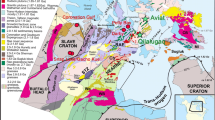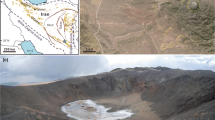Abstract
Minor magmatic intrusions of kimberlite, melilitite and cpx-melilitite occur in the southern part of the Kola Peninsula, Russia, on the Terskii Coast and near the town of Kandalaksha. They yield K-Ar ages of 382 ± 14 Ma and 365 ± 16 Ma, similar to the magmatic rocks from the Kola Alkaline Province. The Terskii Coast kimberlites have mineralogical and geochemical affinities with group 1 kimberlites, whereas the Kandalaksha monticellite kimberlite more closely resembles calcite kimberlites. The lower Al2O3 content in the Kola kimberlites indicates a strongly depleted harzburgitic source, while higher Al2O3 in the melilitites suggests a lherzolitic source. The Terskii Coast kimberlites are anomalously potassic and significantly enriched in P and Ba compared to other group 1 kimberlites. In contrast, the melilitites are sodic and are anomalously depleted in P compared to worldwide melilitites. Trace element patterns of the Kola kimberlites and melilitites indicate the presence of K- and P-rich phases in the mantle source. To account for the K-troughs shown by both magma types, a K-rich phase such as phlogopite is thought to be residual in their sources; however, the anomalous K-enrichment in the Terskii Coast kimberlites may indicate that an additional metasomatic K-rich phase (e.g. K-richterite and/or a complex K-Ba-phosphate) existed in the kimberlite source. The P-depletion in the melilitites may suggest that a phosphate phase such as apatite remained residual in the melilititic source. However, anomalous P-enrichment in the kimberlites cannot be explained by complete melting of the same phase because the kimberlites are a smaller degree melt; thus, it is most likely that another metasomatic phosphate mineral existed in the source of the kimberlites. The Kola kimberlites and melilitites are all strongly LREE-enriched but the kimberlites have a steeper REE pattern and are significantly more depleted in HREE, indicating a higher proportion of garnet in their source. Higher Nb/Y ratios and lower SiO2 values in the kimberlites indicate that they were a smaller degree partial melt than the melilitites. The presence of diamonds in the Terskii Coast kimberlites indicates a relatively deep origin, while the melilitites originated from shallower depth. The non-diamondiferous Kandalaksha monticellite kimberlite has lower abundances of all incompatible trace elements, suggesting a higher degree of partial melting and/or a less enriched and shallower source than the Terskii Coast kimberlites. The 87Sr/86Sri, 143Nd/144Ndi and Pb isotope compositions confirm that the Terskii Coast kimberlites have close affinities with group 1 kimberlites and were derived from an asthenospheric mantle source, while the Kandalaksha monticellite kimberlite and Terskii Coast melilitites were derived from lithospheric mantle. Impact of a Devonian asthenospheric mantle plume on the base of the Archaean-Proterozoic lithosphere of the Kola Peninsula caused widespread emplacement of kimberlites, melilitites, ultramafic lamprophyres and other more fractionated alkaline magmas. The nature of the mantle affected by metasomatism associated with the plume and, in particular, the depth of melting and the stability of the metasomatic phases, gave rise to the observed differences between kimberlites and the related melilitites and other magmas.
Similar content being viewed by others
Author information
Authors and Affiliations
Additional information
Received: 3 March 1997 / Accepted: 7 October 1997
Rights and permissions
About this article
Cite this article
Beard, A., Downes, H., Hegner, E. et al. Mineralogy and geochemistry of Devonian ultramafic minor intrusions of the southern Kola Peninsula, Russia: implications for the petrogenesis of kimberlites and melilitites. Contrib Mineral Petrol 130, 288–303 (1998). https://doi.org/10.1007/s004100050366
Issue Date:
DOI: https://doi.org/10.1007/s004100050366




